It was the first-ever MLS playoff match at Allianz Field when Minnesota United hosted LA Galaxy last weekend. The Loons, after finishing 10th in the Western Conference last season, managed to climb six spots up the table to finish fourth in 2019. The atmosphere in the stadium was electric, especially since the home team’s tactics seemed to be working brilliantly.
Minnesota United dominated the first half, creating chance after chance. Their lack of ruthlessness in front of the net, however, cost them when LA Galaxy scored two goals in four minutes in the second half. Minnesota brought it back to one goal late into the game, but it was too little too late. Find out why Minnesota United’s tactics deserved a win in this MLS tactical analysis.
Lineups
Minnesota United lined up in a standard 4-4-2. Head coach Adrian Heath only made two personnel changes to his team’s 1-0 loss to Seattle Sounders in the last game of the season. Darwin Quintero and Hassani Dotson were dropped in favour of Robin Lod and Kevin Molino. The biggest shock was the exclusion of Quintero who has registered 10 goals and six assists in 31 games for United.
LA Galaxy stuck with their tried and trusted 4-3-3. Guillermo Barros Schelotto also made two changes to his side. Rolf Feltscher was dropped at right-back. Daniel Steres started in his place, but started at centre-back, pushing Giancarlo González out to the right. Joe Corona also made way for Perry Kitchen.
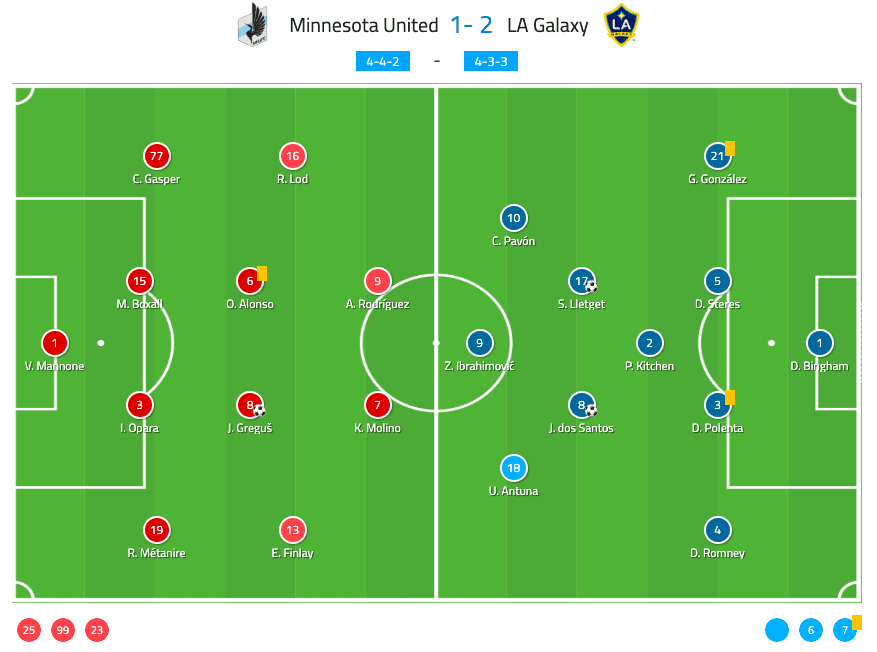
Minnesota United target wide areas
After the first 45 minutes, LA Galaxy were relieved to make it to halftime without conceding. Minnesota United had created chance after chance, but an opening goal continued to allude them. It was more than just luck, however, that presented Minnesota with so many chances. The team’s tactics were obvious; target the flanks and penetrate LA Galaxy with balls from wide areas.
Despite one of their earliest chances coming from the left side of the field, Minnesota targeted the right side of the field for a majority of the match. In fact, 50% of their attacks came down the left side of the field. Only 23% came from the left, while 28% came from central areas. Their eventual goal came after a good passage of play down the right side.
During the goal, Quintero’s assist was a pass back towards the top of the 18-yard box. Ján Greguš placed the shot out of reach of David Bingham. This pass was unlike many of the chances that preceded it, however. Before the goal, Minnesota’s chances came from driving balls into the box, either between or in front of the LA Galaxy defenders.
These passes caught out a disorganized Galaxy backline. Minnesota United attackers were able to get on the end of well-placed passes, but couldn’t find the touch to put the ball past Bingham. This lack of finishing doesn’t take away from the obvious success of Heath’s tactics, though. The inability to make good on these chances will be discussed later.
We can see an example of Minnesota quickly breaking down the right-hand side in the image below. After quickly switching the play, Romain Métanire knocks the ball back to Ján Greguš. Métanire then quickly explodes into the free space after stretching the LA defensive line from the switch in play.
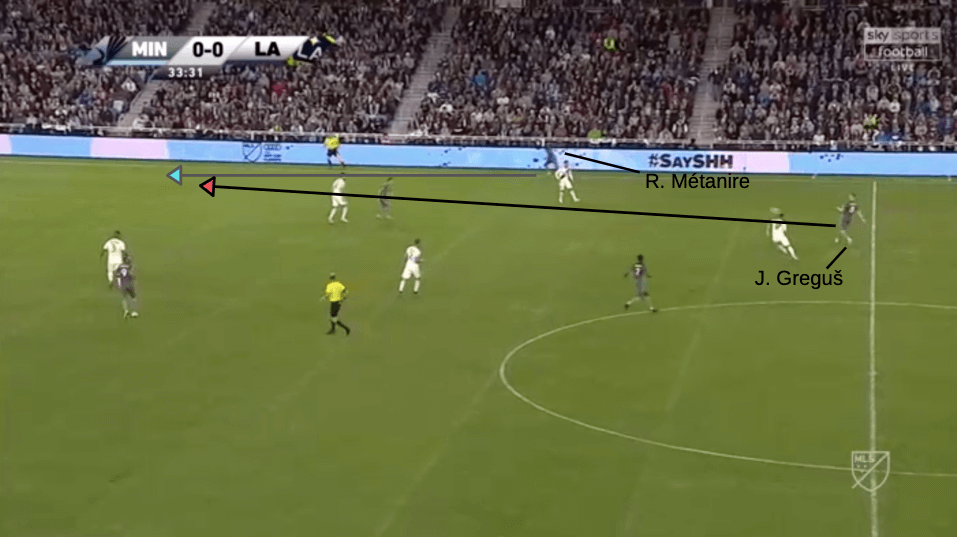
When possessing the ball in deeper areas, Minnesota United were still effective at utilising the wide areas. With LA Galaxy taking up a narrow position when defending deep, Métanire was afforded lots of space out wide. Ethan Finlay’s narrow position created space for the right-back.
In the image below Ángelo Rodríguez plays the ball out to Métanire out wide. He then quickly peels off the back of his defender into the box. The right-back played a great ball into the box where Rodríguez had a free header inside the six-yard box. Unfortunately for Minnesota, he missed the target.
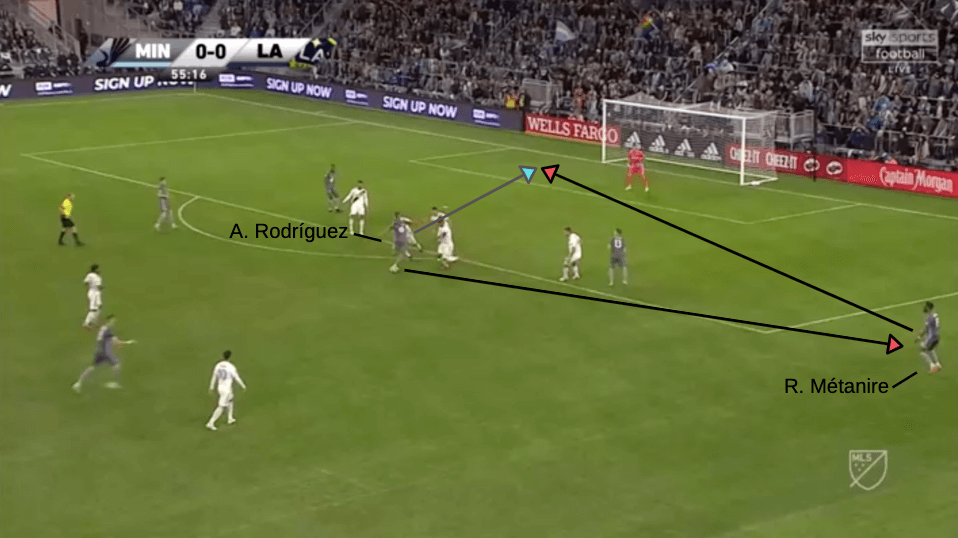
The buildup to these chances came about from effective wing play, however, LA Galaxy’s poor defensive shape aided Minnesota greatly. We will explore this in the next section of this analysis.
LA Galaxy defensively vulnerable
It has been well documented that LA Galaxy’s defence has left much to be desired this season. Schelotto’s team conceded 59 goals in the regular season, the most out of any team to make the playoffs. After watching this game, it is no wonder why. If not for Minnesota United’s inability to be clinical in front of goal, it would be them, not LA Galaxy, facing LAFC in the conference semi-finals.
Firstly, LA Galaxy were caught out on the transition countless times. In the image below, we can see Osvaldo Alonso play a ball into space for Chase Gasper after he dribbled the ball out from the back. We can see how LA Galaxy’s defensive shape affords Minnesota excessive space down the wing. Right-back Giancarlo González can be seen pushed up into the midfield. As the ball is played into Gasper, Minnesota find themselves in a 4v4 centrally.
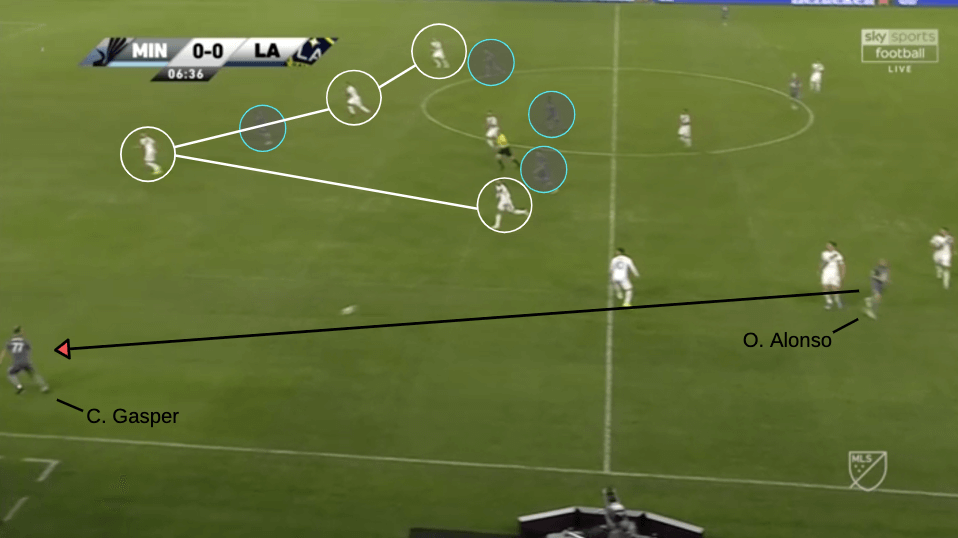
Even in deep spaces, LA Galaxy found themselves disorganised. Once again, Métanire was in the thick of the action in the 77th minute. As Abu Danladi sprinted into the box, the two LA Galaxy centre-backs fail to stick with his run. The full-backs are deeper than their centre-back partners, keeping the striker onside. Danladi has a free shot at the net from the top of the six-yard box, but is denied by Bingham.
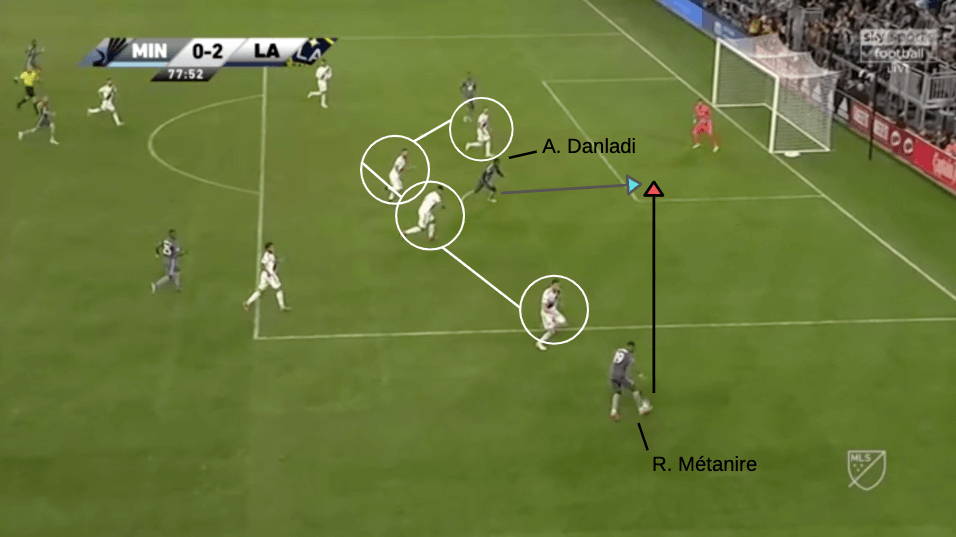
This is one of the many chances that Minnesota United failed to capitalise on. We will now focus on their finishing.
Minnesota United not clinical enough
Arguably the biggest talking point from this match, was Minnesota United being unable to score from their big chances. The tactics discussed in the first section of this analysis showcase just how effective Minnesota United were at chance creation, but their inefficiency in front of goal cost them big time.
The team’s 1.82 xG eclipses that of LA Galaxy’s 1.44. Throughout the season Minnesota United averaged 1.68 goals a game with an xG of 1.67. This suggests that their ability to be clinical in front of goal hasn’t been as big of a problem throughout the season as it was in their biggest match in club history.
The goal they eventually scored had an xG of 0.04, the third-lowest of their 14 chances. The team missed opportunities where the xG was 0.16, 0.24, 0.27, 0.31 and 0.38. LA Galaxy also managed to create some big chances throughout the match, however, far less frequently than their opposition. We can see a map of Minnesota’s chances in the graphic below.
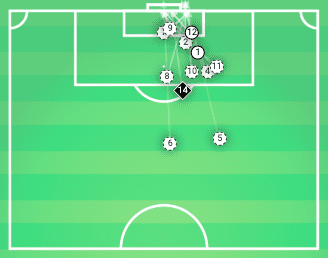
Of their 14 shots, Minnesota only tested Bingham three times, averaging a shots-on-target percentage of 21.43%. LA Galaxy, in contrast, hit their mark 54.55% of the time. Red flags may have surfaced for Heath in their last match of the season when their shots-on-target percentage was 12.5% compared to their season average of 34.7%. We can see Minnesota United’s accuracy below.
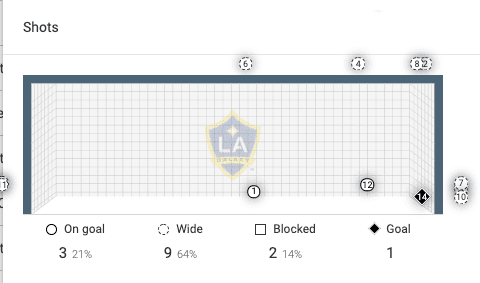
Conclusion
Minnesota United fans and players will likely look back on their first-ever home playoff match with regret. The tactics were effective, but the finishing was not. LA Galaxy, on the other hand, will feel relieved to make it out of the match with a win.
The Galaxy face a much bigger test in the conference semi-final vs LAFC, in the first-ever playoff El Traffico. They will surely need to put in a much more convincing performance tonight if they want to make it through to the next round.

If you love tactical analysis, then you’ll love the digital magazines from totalfootballanalysis.com – a guaranteed 100+ pages of pure tactical analysis covering topics from the Premier League, Serie A, La Liga, Bundesliga and many, many more. Buy your copy of the October issue for just ₤4.99 here





Comments